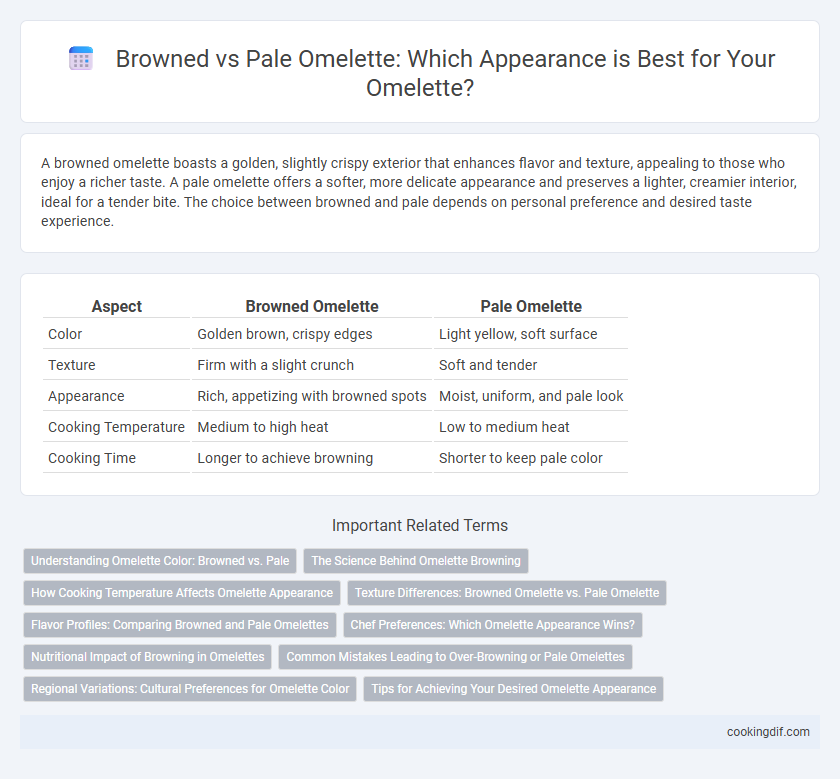A browned omelette boasts a golden, slightly crispy exterior that enhances flavor and texture, appealing to those who enjoy a richer taste. A pale omelette offers a softer, more delicate appearance and preserves a lighter, creamier interior, ideal for a tender bite. The choice between browned and pale depends on personal preference and desired taste experience.
Table of Comparison
| Aspect | Browned Omelette | Pale Omelette |
|---|---|---|
| Color | Golden brown, crispy edges | Light yellow, soft surface |
| Texture | Firm with a slight crunch | Soft and tender |
| Appearance | Rich, appetizing with browned spots | Moist, uniform, and pale look |
| Cooking Temperature | Medium to high heat | Low to medium heat |
| Cooking Time | Longer to achieve browning | Shorter to keep pale color |
Understanding Omelette Color: Browned vs. Pale
Omelette color varies significantly between browned and pale appearances, influenced primarily by cooking temperature and duration. A browned omelette results from Maillard reactions, which develop a richer flavor and a slightly crispy texture, while a pale omelette retains a softer, creamier consistency with a milder taste. Understanding these differences helps achieve the desired balance between flavor intensity and texture in omelette preparation.
The Science Behind Omelette Browning
The science behind omelette browning lies in the Maillard reaction, which occurs when proteins and sugars in eggs undergo a chemical reaction at temperatures above 140degC (284degF), producing a rich brown color and complex flavors. A browned omelette indicates higher heat exposure, resulting in a firmer texture and enhanced savory notes, while a pale omelette is cooked at lower temperatures, preserving a softer, creamier consistency with milder taste. Controlling heat and cooking time directly influences the balance between browning intensity and texture, crucial for achieving the desired omelette quality.
How Cooking Temperature Affects Omelette Appearance
Cooking temperature significantly influences omelette appearance by dictating the degree of browning versus paleness. High heat causes Maillard reactions, leading to a browned, flavorful exterior, while lower temperatures result in a pale, tender texture with minimal browning. Precise temperature control ensures the desired balance between a visually appealing golden-brown surface and a soft, properly cooked interior.
Texture Differences: Browned Omelette vs. Pale Omelette
A browned omelette develops a slightly crispy, caramelized exterior with a firmer texture due to Maillard reaction, adding a savory depth and contrast to the tender interior. In contrast, a pale omelette maintains a soft, fluffy, and delicate texture throughout, preserving a smooth and moist consistency. The choice between browned and pale directly influences the mouthfeel and overall eating experience, balancing crispness against creaminess.
Flavor Profiles: Comparing Browned and Pale Omelettes
Browned omelettes develop a rich, caramelized flavor due to the Maillard reaction, offering a savory and slightly nutty taste that enhances complexity. Pale omelettes maintain a delicate, creamy texture with a subtle egg flavor, highlighting freshness and a lighter mouthfeel. The choice between browned and pale omelettes influences the overall sensory experience by balancing depth of flavor with softness.
Chef Preferences: Which Omelette Appearance Wins?
Chef preferences often favor a lightly browned omelette for its appealing texture and rich, caramelized flavor that enhances the overall taste profile. A pale omelette, while softer and more delicate, may be perceived as undercooked or less flavorful by culinary experts. The browned exterior provides a desirable contrast between crispy edges and a tender interior, making it the preferred choice for many professional chefs.
Nutritional Impact of Browning in Omelettes
Browning an omelette through the Maillard reaction enhances flavor but can reduce certain heat-sensitive nutrients like vitamin B12 and folate. A pale omelette retains higher levels of these vitamins, preserving its nutritional density. However, moderate browning may increase the bioavailability of some proteins and antioxidants, balancing taste with nutritional impact.
Common Mistakes Leading to Over-Browning or Pale Omelettes
Over-browning in omelettes often results from cooking at excessively high heat or leaving the pan unattended too long, causing the eggs to develop an undesirable burnt surface. Conversely, pale omelettes typically occur when the heat is too low or the cooking time is insufficient, preventing the proteins from setting and achieving a golden texture. Proper temperature control and timely flipping are essential to avoid these common appearance issues and ensure an evenly cooked, appetizing omelette.
Regional Variations: Cultural Preferences for Omelette Color
Regional preferences for omelette color vary significantly; in France, a pale, tender omelette is favored for its delicate texture and subtle flavor, reflecting culinary traditions that prioritize refinement. Conversely, in parts of the United States and Spain, a browned omelette with a slight caramelized crust is preferred, offering a heartier taste and more robust appearance that align with local palates. These cultural distinctions influence how chefs achieve the ideal cooking time and heat level to match regional expectations for omelette appearance and flavor.
Tips for Achieving Your Desired Omelette Appearance
To achieve a browned omelette, cook over medium heat and allow the eggs to set without stirring, creating a golden crust that adds texture and flavor. For a pale omelette, use low heat and gently cook while frequently stirring to maintain a soft, tender appearance. Adjusting heat control and cooking time precisely ensures you get the perfect omelette surface, whether you prefer browned or pale.
Browned vs Pale for omelette appearance Infographic

 cookingdif.com
cookingdif.com